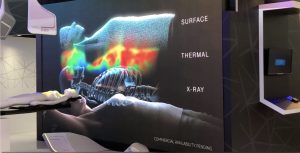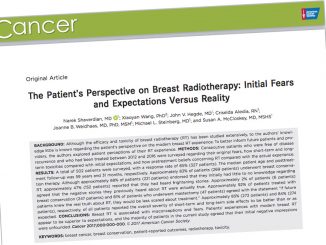The potential for combining radiotherapy with immunotherapy is enormous, yet experts say that radio-immunotherapy still has a long way to go before entering into routine clinical practice
One of the hot topics discussed at ESTRO38, the annual congress of European Society for Radiotherapy and Oncology (ESTRO), was combining radiotherapy (RT) with immunotherapy. Just to get an idea of the excitement about this new approach, the word “immunotherapy” appeared 132 times in the abstract book of the congress. Which is the underlying rationale for combining the two types of therapy and where we are in this respect?
The elusive abscopal effect
The origin of the story is the description of the “abscopal effect”. The word “abscopal” (from Latin: ab= away, scopus = target) was coined in 1953 by R.H. Mole to indicate “an action at a distance from the irradiated volume but within the same organism” (Br J Radiol. 1953;26:234-241. doi:10.1259/0007-1285-26-305-234). The abscopal effect refers to cases of patients that were irradiated at one site and obtained regression of metastatic cancer at distant sites. It has been reported for several cancers, including melanoma, renal cell carcinoma, breast cancer, hepatocellular carcinoma, and other metastatic solid tumours (Nat Rev Cancer. 2018;18:313-322. doi:10.1038/nrc.2018.6). Nevertheless, the abscopal effect is very rare: between 1969 and 2014, there have been only 46 case reports of the abscopal effect from radiotherapy alone (Curr Probl Cancer. 2016;40:25-37. doi:10.1016/j.currproblcancer.2015.10.001).
The abscopal effect has been connected to mechanisms involving the immune system. In fact, studies that compared immunocompetent and immunocompromised mice demonstrated an association between immune status, local response to radiotherapy and metastasis. The abscopal response mechanism has been partially elucidated. When a tumour is irradiated, it releases tumour-associated antigens that are captured by antigen-presenting cells (APCs) and presented to T cells. Irradiated cells also release other molecules and cytokines that enhance traffic of immune cells. Radiotherapy acts as a vaccination: activated T cells can recognise and attack both the primary and metastatic disease. The reason why this happens so rarely is the presence of immunosuppression or tolerance at tumour sites.
Boosting the abscopal effect
Using immunotherapy is the logical approach to overcome the suppressive effect of the tumour microenvironment and enhance local and systemic anti-tumour immunity. Various preclinical studies demonstrated that combining RT with immunotherapy improves abscopal response rates. Several immunotherapeutic agents have been tested so far, for example, the cytokine FLT3L that recruits and stimulates APCs. A relevant proportion of studies is investigating immune checkpoint inhibitors (ICIs), monoclonal antibodies that target immune checkpoints activating T cell responses by interrupting co-inhibitory signalling pathways.
The first clinical trial designed to generate abscopal responses in patients with metastatic solid tumours was conducted by the group of Silvia Chiara Formenti at the Weill Cornell Medical College, New York City (USA). They looked at the effect of radiation in combination with granulocyte-macrophage colony-stimulating factor (GM-CSF), an immunomodulatory cytokine, in patients with metastatic solid tumours. The combination of RT with GM-CSF produced objective abscopal responses in about one fourth of the patients enrolled in the proof-of-principle trial (Lancet Oncol. 2015;16:795-803. doi:10.1016/S1470-2045(15)00054-6). Notably, the patients who had an abscopal response lived longer than those who did not have an abscopal response. Briefly after, other investigators launched studies, mostly non-randomised, to test the combination of RT with ICIs (anti-PD-1/PD-L1 and anti-CTLA-4 antibodies), obtaining promising results.
Open questions
Studies conducted so far provided increasing evidence that the combination with immunotherapy can extend the use of radioimmunotherapy to the treatment of local and metastatic cancer. “The Tsunami of immuno-oncology is opening the doors to different kinds of disease to be eligible for radiotherapy” said Umberto Ricardi, head of the Department of Oncology at the University of Turin, Italy, and President of ESTRO. “We are focusing on the oligometastatic disease and the possibility to integrate local ablative therapies, like stereotactic body radiotherapy, for treating such kind of disease”. However, much remains to be done in terms of identification of optimal regimens of radio-immunotherapy. “As radiotherapy and immunotherapy is a whole new field, there is still debate about the need to revisit our radiation schedules and indications – declares Eric Deutsch, Head of the Radiation Oncology Department of the Institute Gustave Roussy (Villejuif, France) – Ongoing translational efforts will be key to bridge preclinical data and the results of clinical trials. Amongst the key questions to be answered are the following: do we still need to irradiate the same tumour volumes? Do we have to avoid the irradiation of draining lymph nodes and then reduce our radiation volumes? This would have significant implications in terms of late effects… But the evidence is still lacking.

Regarding dosing and scheduling, the magnitude of the questions is also very important. Preclinical data suggest, equivocally, that decreasing a high dose by too much per session might lose the ability to propagate the immune response and also that some regimens, much shorter than the currently used radiotherapy schemes, may be optimal to synergise with immunotherapy. The important point here is that we are at the beginning of the story and that we still need to learn from preclinical, translation and clinical data.
Radio-immunotherapy also calls for new methods to monitor clinical responses. “There are several ways to monitor the response, the best being achieving immediate shrinkage of both irradiated and unirradiated tumours and eventually prolonged survival – says Deutsch, who adds – Several other approaches are currently being developed: biological biomarkers such as an expansion of the T cell repertoire, or an increase in immune effectors into the tumour, for instance. We have developed a radiomics signature based on artificial intelligence methods that, based on regular CT images, helps to define tumours benefiting from immunotherapy given alone. We are now expanding our investigations to implement radiomics as a non-invasive tool to assess before and during radio-immunotherapy the response to the combination”.
Caution, please
Some radiation oncologists, while acknowledging the potential of combining radiotherapy with immunotherapy, wait for solid evidence before choosing to believe that immunotherapy is really changing radiation oncology. This is well elucidated by Michael Baumann, Scientific Director and CEO of the German Cancer Research Centre (DKFZ) in Heidelberg: “Immunotherapy without doubt is a breakthrough in cancer research and is in the meantime clinically established as a 4ththerapeutic pillar in parallel to surgery, radiotherapy and chemotherapy/targeted therapy. The Nobel prize for the development of immunotherapy is therefore very important and deserved. However, so far we only know that immunotherapy also works when given in combination, mostly after radiotherapy. We also do not have an indication that immunotherapy is really changing radiotherapy in the sense that current dose or volume concepts can be modified. The so-called abscopal effect seems to be a rare event. We know that radiotherapy can be immunostimulatory or immunosuppressive and it will be important to get more insights on a fundamental level. Also, it is important to perform immune basic research on interactions of the immune system with cancer, as many data show that immunotherapy works in a proportion of cancer while other tumours are resistant. Currently, the mechanisms are unclear”. His conclusion is trenchant: “I think that immunotherapy and radiotherapy should not be combined outside of clinical trials or outside of indicatives which have already been tested in large randomised trials, such as in non-small cell lung cancer”.
A similar opinion is expressed by Kevin Harrington, Joint Head of the Division of Radiotherapy and Imaging at The Institute of Cancer Research, London (UK), about the combination of ICIs and radiotherapy: “The situation we are in at the moment is that we have a lot of anecdotal data about combining immune checkpoint inhibitors and radiotherapy. We have increasing amounts of data from a large series of patients who have been prospectively recruited into studies, many not randomised. We have hints that the combination of an immune checkpoint inhibitor (both CTLA-4 blockade and PD-1/PD-L1-blockade) may be interacting in a good fashion with radiation to generate anti-tumour immune responses, but we don’t yet have clear evidence from randomised studies that this should be the way we should practice. Moreover, we do not know the optimum dose fractionation schedules yet. Until we have those data, this approach has to remain experimental and everything should be done in clinical trials. There is enough preliminary data to suggest that this is going to be a very fruitful avenue of research and I think that looking in the future, the combination of immune checkpoint inhibitors with radiation or chemoradiation may become a new standard of care in a range of tumour types, but we have to have randomised trial data before we can conclude that”.
Three is better
“Understanding biology is the key to successful clinical translation. In recent years, we have begun to comprehend in great detail the biological effects of radiation on tumour and normal cells.In particular, we have a much clearer perspective on the importance of molecular responses to DNA damage and their interactions with immune sensing mechanisms in the cell” says Harrington, suggesting further possibilities to exploit radiation-induced immunogenic cell death for patient benefit.
“Cytoplasmic DNA release in response to radiation appears to be a really important trigger for type I interferon responses that can drive anti-tumour responses. Also, cytoplasmic DNA activates the cGAS/STING pathway that can dictate the immunogenicity of dying cells. Drugs that targetDNA damage repair, drugs acting on the cytosolic DNA sensing pathway, and innate immune activators, all have the potential to feed into the combination strategy. They can “heat up” immunologically “cold tumours” and lead to immune infiltrates capable of mediating anti-tumour effects.
The immune checkpoint inhibitor is what you need to allow the T cell to execute the tumour cell, because, without that, the tumour cell has the ability to turn-off the T cell. These novel agents have the potential to make the T cell more likely to be in the position to attack the tumour cells and for the death that occurs to be seen in a more immunologically relevant way. There is a high likelihood that we will generate double and triple combinations therapies with radiation in order to drive immune responses”.
Radio-immunotherapy is an auspicious approach that definitely calls for more research and, above all, more clinical trials.






Leave a Reply